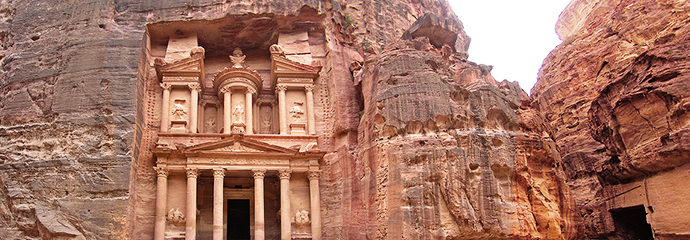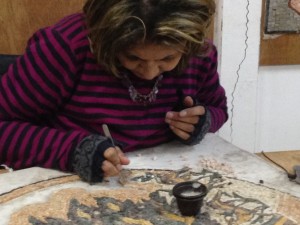
Jordan Trip – 6
We began the day in one of the seven wonders of the ancient world– the city of Petra. This place was the capital of the Nabatean empire that ruled this area from the 3rd century B.C.-2nd century A.D. Their name, which means “the carvers,” suggests their legacy. They carved massive buildings out of sandstone that still remain for centuries. The 2-mile-long gorge that leads into Petra is commonly associated with the biblical Selah in Isaiah 16. Herod the Great’s mother was Nabatean. The weather today was brisk and cool; and after a wonderful tour, we traveled to the ancient crusader castle in Shawbak and took pictures overlooking the Arnon River. We concluded the day by visiting Mount Nebo, where Moses saw the Promised Land before he died. We shopped at a beautiful school and store that sells hand-made Mosaics nearby. They provide jobs to special needs people who work for two months to make one mosaic table top.
As we traveled, we reflected on the significant passages from Exodus 16-18, Numbers 20-21, and Deuteronomy 34. We felt like Israelites wandering through desert pathways, retracing the steps of our ancestors. The Israelites were sent to be a “light to the nations.” On the journey, we had some remarkable conversations about the gospel.
Jordan is a country in transition; 5-10% of the population is Christian. Over 1.5 million Syrian refugees are here. Two-thirds of them have housing; 500,000 live in tents and camps supplied by the U.N. Our guide in Jordan is an evangelical Christian, and he shared about the conditions of the country and the opportunities that the Lord is providing.
One of our guide’s friends has started a church about seven miles from Madaba in a Christian village. When he arrived, he prayed for people to come; but most of the Christians did not trust each other. As the Syrian refugee crisis unfolded, he realized he had an opportunity. He opened his doors to these refugees, who are primarily Muslim, on Thursday nights. They chose this night for their own safety. The pastor ministers to the needy, provides food, hospitality, and shelter, and teaches a Bible study. He uses the book of Job for the study because Muslims recognize him from the Koran. As our guide told me, “My friend prayed for people to come, and the Lord has sent them.”
At the mosaic store, I had tea with our guide, the bus driver, and the police officer that accompanies our group. The driver and officer are Muslim. While waiting for the group to shop, the officer saw a hand-painted ostrich egg depicting a crucified Jesus. He wondered what the picture meant and asked our guide to explain it to him. After he shared with the officer the story of Jesus, I had the opportunity to explain to him the Good Friday and Easter celebrations we observe as Christians. The officer mentioned that Muslims had just finished celebrating their own Festival of Sacrifice, commemorating Abraham’s attempted sacrifice of his son, called “Eid Al-Adha”. I explained the differences between this sacrifice and the one that Jesus’ offered for our sins.
When we arrived at our hotel, we were greeted by one of FBCTLH’s own, Barbara Johnson. She has taught music and arts at the Baptist school in Aman for 27 years. She is a graduate of FSU and attended FBC in college. Cal and Rose Zongker were her Sunday School teachers. We presented Barbara with her own FSU national championship t-shirt.
We started by visiting an ancient civilization and finished the day as if we had been on mission for God. Please pray for the people in these conversations that God will continue to speak to them.








